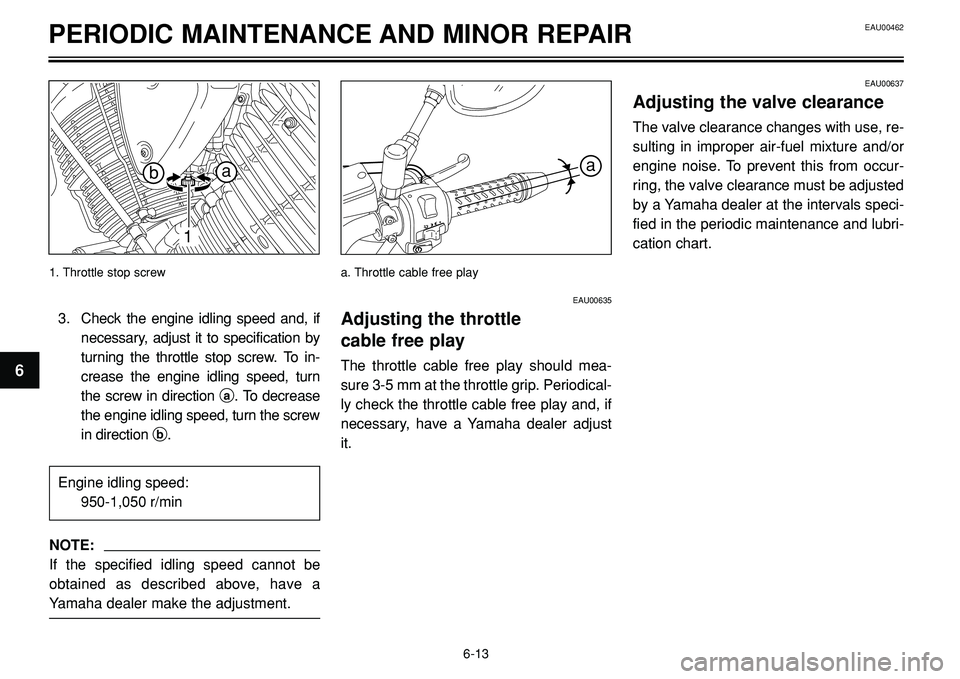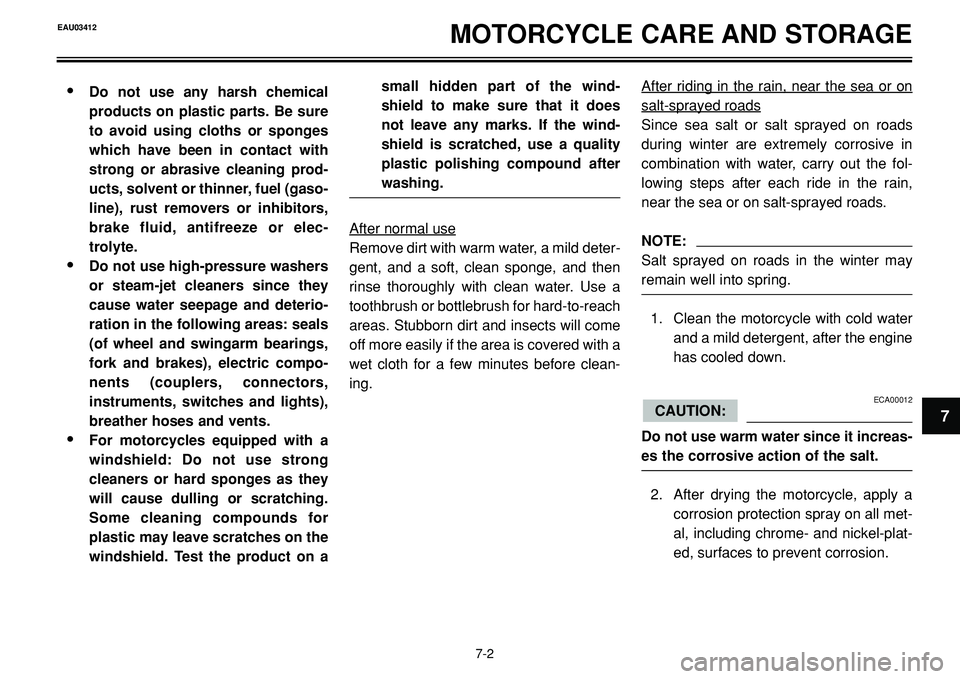Page 54 of 96

EAU00462PERIODIC MAINTENANCE AND MINOR REPAIR
EAU00630
Adjusting the carburetors
The carburetors are important parts of the
engine and require very sophisticated ad-
justment. Therefore, most carburetor ad-
justments should be left to a Yamaha deal-
er, who has the necessary professional
knowledge and experience. The adjust-
ment described in the following section,
however, may be serviced by the owner as
part of routine maintenance.
EC000095
The carburetors have been set and
extensively tested at the Yamaha facto-
ry. Changing these settings without
sufficient technical knowledge may
result in poor performance of or dam-
age to the engine.
CAUTION:
EAU01168
Adjusting the engine idling
speed
The engine idling speed must be checked
and, if necessary, adjusted as follows at
the intervals specified in the periodic main-
tenance and lubrication chart.
NOTE:
A diagnostic tachometer is needed to
make this adjustment.
1. Attach the tachometer to the spark
plug lead.
2. Start the engine and warm it up for
several minutes at 1,000-2,000 r/min
while occasionally revving it to
4,000-5,000 r/min.
NOTE:
The engine is warm when it quickly
responds to the throttle.
6-12
6
1
2
1. Pin (x 2)
2. Pin seat (x 2)
EWA00052WARNING0
Before installing the fuel tank, make
sure that the fuel hoses are not dam-
aged. If any fuel hose is damaged, do
not start the engine but have a Yamaha
dealer replace the hose, otherwise fuel
may leak.
Make sure that the fuel hoses are prop-
erly connected and routed, and not
pinched.
Be sure to place the fuel tank breather
hose in the original position.
12. Install the seat.
Page 55 of 96

EAU00462PERIODIC MAINTENANCE AND MINOR REPAIR
a
EAU00635
Adjusting the throttle
cable free play
The throttle cable free play should mea-
sure 3-5 mm at the throttle grip. Periodical-
ly check the throttle cable free play and, if
necessary, have a Yamaha dealer adjust
it.
EAU00637
Adjusting the valve clearance
The valve clearance changes with use, re-
sulting in improper air-fuel mixture and/or
engine noise. To prevent this from occur-
ring, the valve clearance must be adjusted
by a Yamaha dealer at the intervals speci-
fied in the periodic maintenance and lubri-
cation chart.
6-13
6
a. Throttle cable free play
1
ba
3. Check the engine idling speed and, if
necessary, adjust it to specification by
turning the throttle stop screw. To in-
crease the engine idling speed, turn
the screw in direction a. To decrease
the engine idling speed, turn the screw
in direction b.
Engine idling speed:
950-1,050 r/min
NOTE:
If the specified idling speed cannot be
obtained as described above, have a
Yamaha dealer make the adjustment.
1. Throttle stop screw
Page 77 of 96
EAU00462PERIODIC MAINTENANCE AND MINOR REPAIR
EAU01008
Troubleshooting
Although Yamaha motorcycles receive a
thorough inspection before shipment from
the factory, trouble may occur during oper-
ation. Any problem in the fuel, compres-
sion, or ignition systems, for example, can
cause poor starting and loss of power.
The following troubleshooting chart repre-
sents a quick and easy procedure for
checking these vital systems yourself.However, should your motorcycle require
any repair, take it to a Yamaha dealer,
whose skilled technicians have the neces-
sary tools, experience, and know-how to
service the motorcycle properly.
Use only genuine Yamaha replacement
parts. Imitation parts may look like Yama-
ha parts, but they are often inferior, have a
shorter service life and can lead to expen-
sive repair bills.
6-35
6
Page 78 of 96

EAU00462PERIODIC MAINTENANCE AND MINOR REPAIR
EAU01297
Troubleshooting chart
EW000125WARNING0
Keep away open flames and do not smoke while checking or working on the fuel system.
6-36
6
Check the fuel level in the
fuel tank.
1. Fuel
2. Compression
3. Ignition
4. BatteryThere is enough fuel.
There is no fuel.
Check the compression.
Supply fuel.The engine does not start. Check the compression.
There is compression.Check the ignition.
Have a Yamaha dealer check
the vehicle.
Wipe off with a dry cloth and correct the spark
plug gaps, or replace the spark plugs.Open the throttle halfway and operate the
electric starter.
Have a Yamaha dealer check
the vehicle.The engine does not start.
Check the battery.
The engine turns over slowly.
Have a Yamaha dealer check
the vehicle.
There is no compres-
sion.
Wet.
Dry
The engine turns over quickly.The battery is good.
Check the battery lead connections, and
charge the battery if necessary.The engine does not start.
Operate the electric
starter.
Remove the spark plugs
and check the electrodes.
Operate the electric
starter.
Page 81 of 96

MOTORCYCLE CARE AND STORAGE
•Do not use any harsh chemical
products on plastic parts. Be sure
to avoid using cloths or sponges
which have been in contact with
strong or abrasive cleaning prod-
ucts, solvent or thinner, fuel (gaso-
line), rust removers or inhibitors,
brake fluid, antifreeze or elec-
trolyte.
•Do not use high-pressure washers
or steam-jet cleaners since they
cause water seepage and deterio-
ration in the following areas: seals
(of wheel and swingarm bearings,
fork and brakes), electric compo-
nents (couplers, connectors,
instruments, switches and lights),
breather hoses and vents.
•For motorcycles equipped with a
windshield: Do not use strong
cleaners or hard sponges as they
will cause dulling or scratching.
Some cleaning compounds for
plastic may leave scratches on the
windshield. Test the product on asmall hidden part of the wind-
shield to make sure that it does
not leave any marks. If the wind-
shield is scratched, use a quality
plastic polishing compound after
washing.
After normal use
Remove dirt with warm water, a mild deter-
gent, and a soft, clean sponge, and then
rinse thoroughly with clean water. Use a
toothbrush or bottlebrush for hard-to-reach
areas. Stubborn dirt and insects will come
off more easily if the area is covered with a
wet cloth for a few minutes before clean-
ing.After riding in the rain, near the sea or on
salt-sprayed roads
Since sea salt or salt sprayed on roads
during winter are extremely corrosive in
combination with water, carry out the fol-
lowing steps after each ride in the rain,
near the sea or on salt-sprayed roads.
NOTE:
Salt sprayed on roads in the winter may
remain well into spring.
1. Clean the motorcycle with cold water
and a mild detergent, after the engine
has cooled down.
ECA00012
Do not use warm water since it increas-
es the corrosive action of the salt.
2. After drying the motorcycle, apply a
corrosion protection spray on all met-
al, including chrome- and nickel-plat-
ed, surfaces to prevent corrosion.
CAUTION:
EAU03412
7-2
7
Page 83 of 96

MOTORCYCLE CARE AND STORAGE
Storage
Short-term
Always store your motorcycle in a cool, dry
place and, if necessary, protect it against
dust with a porous cover.
ECA00014
•Storing the motorcycle in a poorly
ventilated room or covering it with
a tarp, while it is still wet, will allow
water and humidity to seep in and
cause rust.
•To prevent corrosion, avoid damp
cellars, stables (because of the
presence of ammonia) and areas
where strong chemicals are
stored.
CAUTION:Long-term
Before storing your motorcycle for several
months:
1. Follow all the instructions in the
“Care” section of this chapter.
2. For motorcycles equipped with a fuel
cock that has an “OFF” position: Turn
the fuel cock lever to “OFF”.
3. Drain the carburetor float chambers
by loosening the drain bolts; this will
prevent fuel deposits from building
up. Pour the drained fuel into the fuel
tank.
4. Fill up the fuel tank and add fuel sta-
bilizer (if available) to prevent the fuel
tank from rusting and the fuel from
deteriorating.
5. Perform the following steps to protect
the cylinders, piston rings, etc. from
corrosion.a. Remove the spark plug caps and
spark plugs.
b. Pour a teaspoonful of engine oil into
each spark plug bore.
c. Install the spark plug caps onto the
spark plugs, and then place the spark
plugs on the cylinder head so that the
electrodes are grounded. (This will
limit sparking during the next step).
d. Turn the engine over several times
with the starter. (This will coat the
cylinder walls with oil).
e. Remove the spark plug caps from the
spark plugs, and then install the spark
plugs and the spark plug caps.
EWA00003WARNING0
To prevent damage or injury from
sparking, make sure to ground the
spark plug electrodes while turning the
engine over.
7-4
7
EAU03412
Page 86 of 96

SPECIFICATIONSEAU01038
8-1
8
Specifications
ModelBT1100
Dimensions
Overall length 2,200 mm
Overall width 800 mm
Overall height 1,140 mm
Seat height 812 mm
Wheelbase 1,530 mm
Ground clearance 168 mm
Minimum turning radius 2,980 mm
Basic weight
(with oil and full fuel tank)250.5 kg
Engine
Engine type Air-cooled 4-stroke,
SOHC
Cylinder arrangement V type 2-cylinder
Displacement 1,063 cm
3
Bore x stroke 95.0 x 75.0 mm
Compression ratio 8.3 : 1
Starting system Electric starter
Lubrication system Wet sumpEngine oil
Ty p e
Recommended API Service SE, SF, SG or
engine oil classification higher
Be sure to use motor oils that do not contain anti-friction modifiers.
Passenger car motor oils (often labeled “ENERGY CONSERVING II”)
contain anti-friction additives which will cause clutch and/ or starter
clutch slippage, resulting in reduced component life and poor
engine performance.8
Quantity
Without oil filter
cartridge replacement 3.0 L
With oil filter cartridge
replacement 3.1 L
Total amount
(dry engine) 3.6 L
CAUTION:
-20-10 0 1020304050°C
SAE 10W-30
SAE 10W-40
SAE 20W-40
SAE 15W-50
SAE 15W-40
Page 87 of 96
SPECIFICATIONSEAU01038
8-2
8
Final gear oil
Type Hypoid gear oil SAE 80
(API GL4) or multigrade hypoid
gear oil SAE 80W-90
Quantity 0.2 L
Air filterDry type element
Fuel
Type Regular unleaded gasoline
Fuel tank capacity 20 L
Fuel reserve amount 5.8 L
Carburetor
Manufacturer MIKUNI
Model x quantity BSR37 x 2
Spark plug
Manufacturer/model NGK / BPR7ES or
DENSO / W22EPR-U
Gap 0.7–0.8 mm
Clutch type Wet, multiple-disc
Transmission
Primary reduction system Spur gear
Primary reduction
ratio 1.660
Secondary reduction
system Shaft drive
Secondary reduction
ratio 2.875
Transmission type Constant mesh 5-speed
Operation Left footGear ratio 1st2,353
2nd1,667
3rd1,286
4th1,032
5th0,853
Chassis
Frame type Twin tube Backbone
Caster angle 25°
Trail 106 mm
Tires
Front
Type Tubeless
Size 120/70-ZR17 (58W)
Manufacturer/ Dunlop / D205F TL
model Metzeler / MEZ3F TL
Rear
Type Tubeless
Size 170/60-ZR17 (72W)
Manufacturer/ Dunlop / D205 TL
model Metzeler / MEZ3 TL
Maximum load* 200 kg